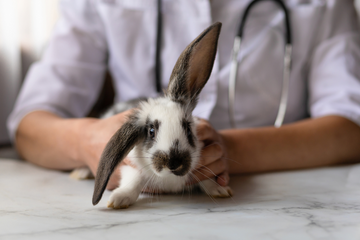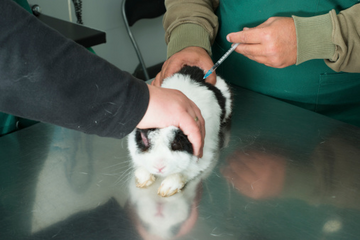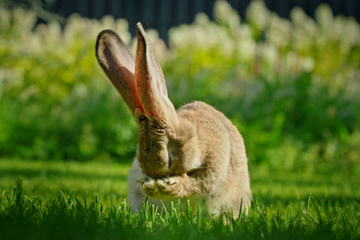Tricks for Encouraging Hay Eating in Pets
When you bring a rabbit into your life, you're welcoming in a quirky little personality. With that also comes a unique set of challenges—one of the most common being getting your rabbit to eat enough hay.
Click Here For a Guide to Understanding Your Rabbits Diet.

Sometimes, rabbits act like toddlers. They gravitate toward the tastier, sweeter treats and ignore what's good for them. If your rabbit is turning their nose up at their hay, you're not alone. Fortunately, a few changes can usually get them munching again.
Understanding Why Hay is So Important
A rabbit's diet should be at least 80% high-quality grass hay. Timothy Hay, Orchard Grass, and Mountain Grass are all excellent options. Hay keeps their digestive system healthy and their teeth properly worn down, helping prevent painful dental issues and dangerous gastrointestinal problems.
If hay isn't a regular part of your rabbit's meals, you're risking obesity, digestive blockages, and a lot of unnecessary vet visits. Encouraging hay eating isn't just a good idea—it's necessary for a healthy rabbit life.

How Habits and Environment Affect Hay Eating
Sometimes, your rabbit isn't eating hay has more to do with what you've been offering than the rabbit's preferences. Hay will feel like a second-rate option if a bunny grows up eating mostly pellets, fruits, and veggies.
Luckily, habits can change. Rabbits introduced to Timothy Hay early—and consistently—develop lifelong hay-eating habits. Even adult rabbits can be retrained with a little effort. It starts by cutting back on pellets and treats, and making hay the main course.
Encouraging Hay Eating: Freshness Matters
Would you want to eat stale food? Your rabbit doesn't either. If the hay you're offering is yellowed, dusty, or smells off, they'll avoid it.
When choosing hay, look for green, fragrant bundles that are full of life. High-quality hay not only smells better but also contains more nutrients. If you're unsure about freshness, ordering directly from a trusted supplier like Rabbit Hole Hay ensures farm-to-doorstep quality.
Tips for Encouraging Hay Eating
If you've checked freshness off the list, but your rabbit is still hesitant, here are some practical strategies:
Mix Hay Types: Try offering a variety like Timothy, Orchard, and Mountain Grass. Some rabbits have a clear favorite!
Change Up the Location: Rabbits love to munch while they potty. Place hay over or beside the litter box to take advantage of this habit.
Offer Fresh Batches Often: Switch out hay daily. Old hay sitting for days loses its appeal—and nutrients.
Mind the Quantity: Give enough for a day's worth of eating, but avoid overwhelming piles that sit and spoil.
Proper Storage: Store hay in a cool, dry area in a breathable bag, not sealed in plastic. Keeping it fresh makes a huge difference.
Age-Appropriate Hay Choices
Baby rabbits under seven months old need more calories and nutrients for growth. That’s where Alfalfa Hay comes in. It's richer and more calorie-dense than grass hay.
Once a rabbit matures, it's crucial to switch them to lower-calorie grass hays like Timothy Hay to prevent weight gain and promote long-term health.

When Something Might Be Wrong
Sometimes the issue isn't stubbornness—it's health. Rabbits are excellent at hiding sickness, so a sudden refusal to eat could mean they're in pain.
Call your vet immediately if your rabbit isn't eating hay, treats, or even their favorite foods. Quick action can make all the difference.
Small Changes, Big Improvements
Small changes to your rabbit's setup can really help encourage hay eating. If your bun is avoiding hay, take a fresh look at their environment:
Combine Hay and Litter Boxes: Rabbits naturally graze while using the bathroom, so put the hay right where they're most comfortable.
Keep Water Clean: Dirty or contaminated water discourages eating. Refresh your rabbit's water daily and clean the bowl often.
Limit Treats: Fruits and veggies should only be occasional treats, not dietary staples.
Helpful Resources for Encouraging Hay Eating
If you want a deeper dive into what makes a perfect rabbit diet, the Hay is for Rabbits eBook is packed with everything you need to know.
You can also check out helpful information about getting rabbits to eat more Timothy Hay for even more detailed tips and tricks that work.
When you're ready to stock up on hay, or if you want to let your rabbit sample different varieties, you can explore fresh options here.

Final Thoughts on Encouraging Hay Eating
Building good hay habits isn't complicated but requires consistency. Offer fresh, high-quality hay daily, limit other foods, and make hay easily accessible. Monitor your rabbit's eating habits to catch any signs of trouble early.
Rabbits are wonderful companions, and encouraging hay eating is one of the best things you can do to keep them happy and healthy. A little persistence now pays off for a lifetime of binkies, nose boops, and good health!
Key Takeaways
Always provide high-quality, fresh grass hay as the main part of your rabbit's diet.
Use creative placement and multiple hay types to spark your rabbit's interest.
Pay attention to any change in eating habits and call a vet if concerns arise.

Should You Get Rabbit Pet Insurance? Here's Everything You Need to Know

Rabbit Vaccination Schedule: A Simple Guide










